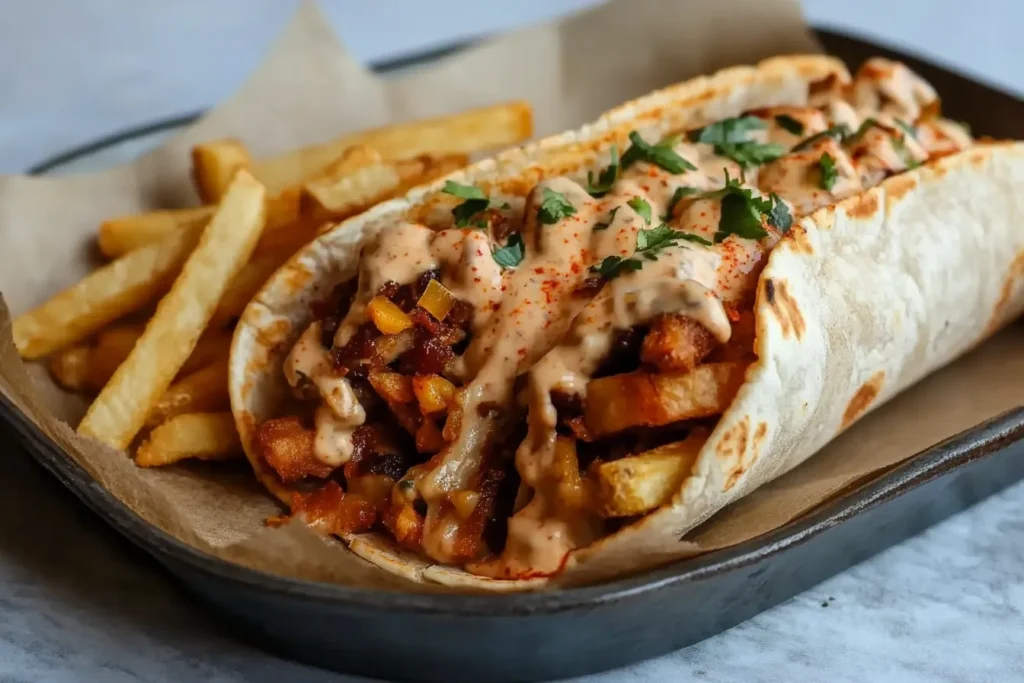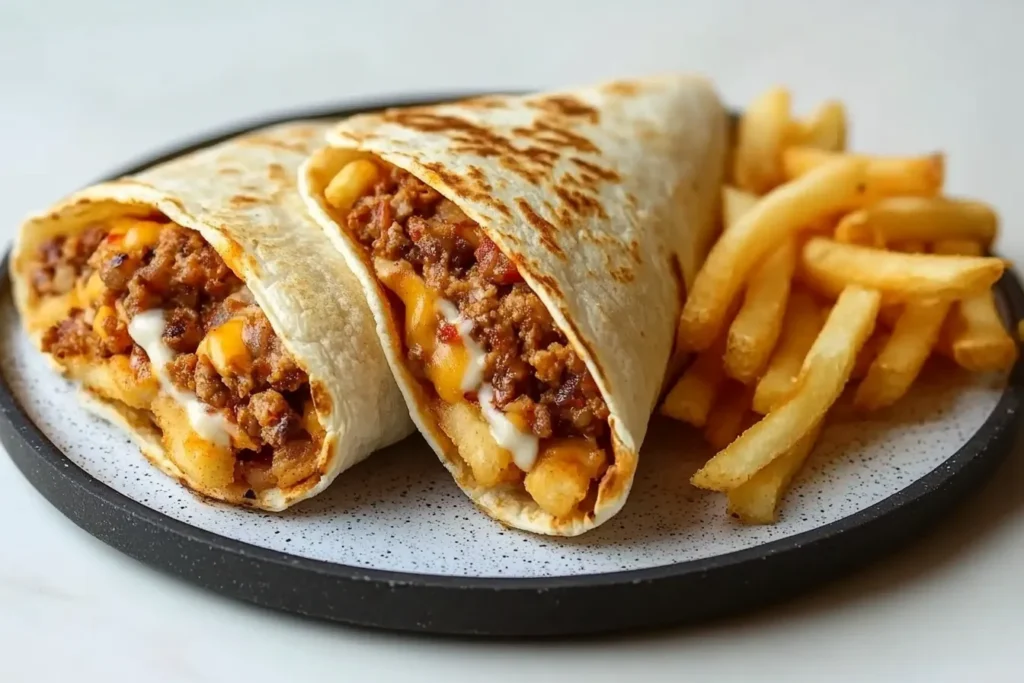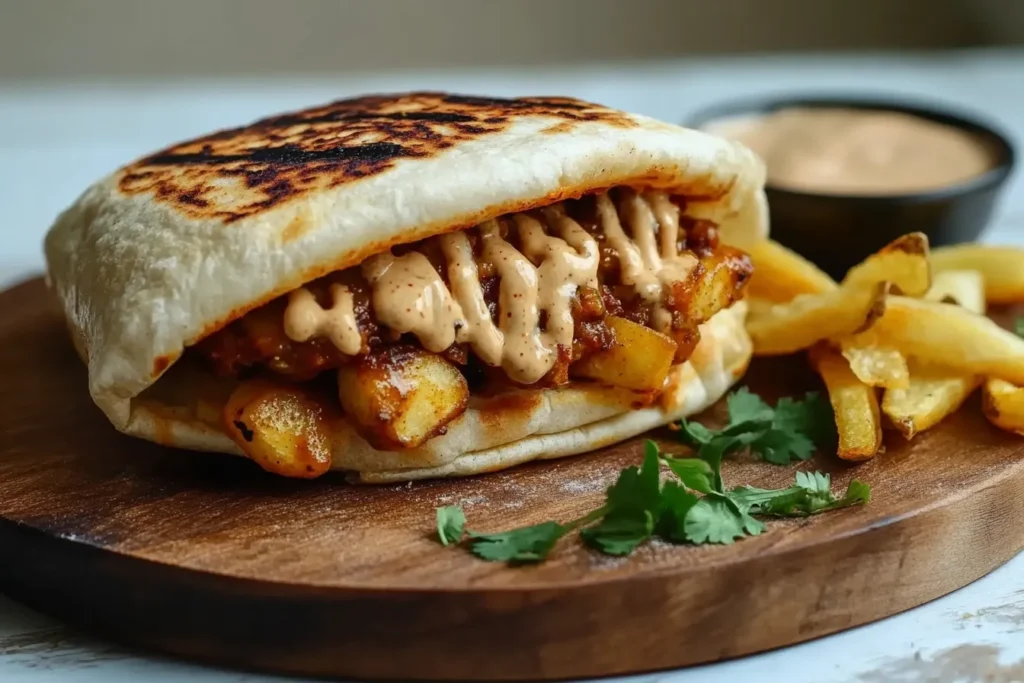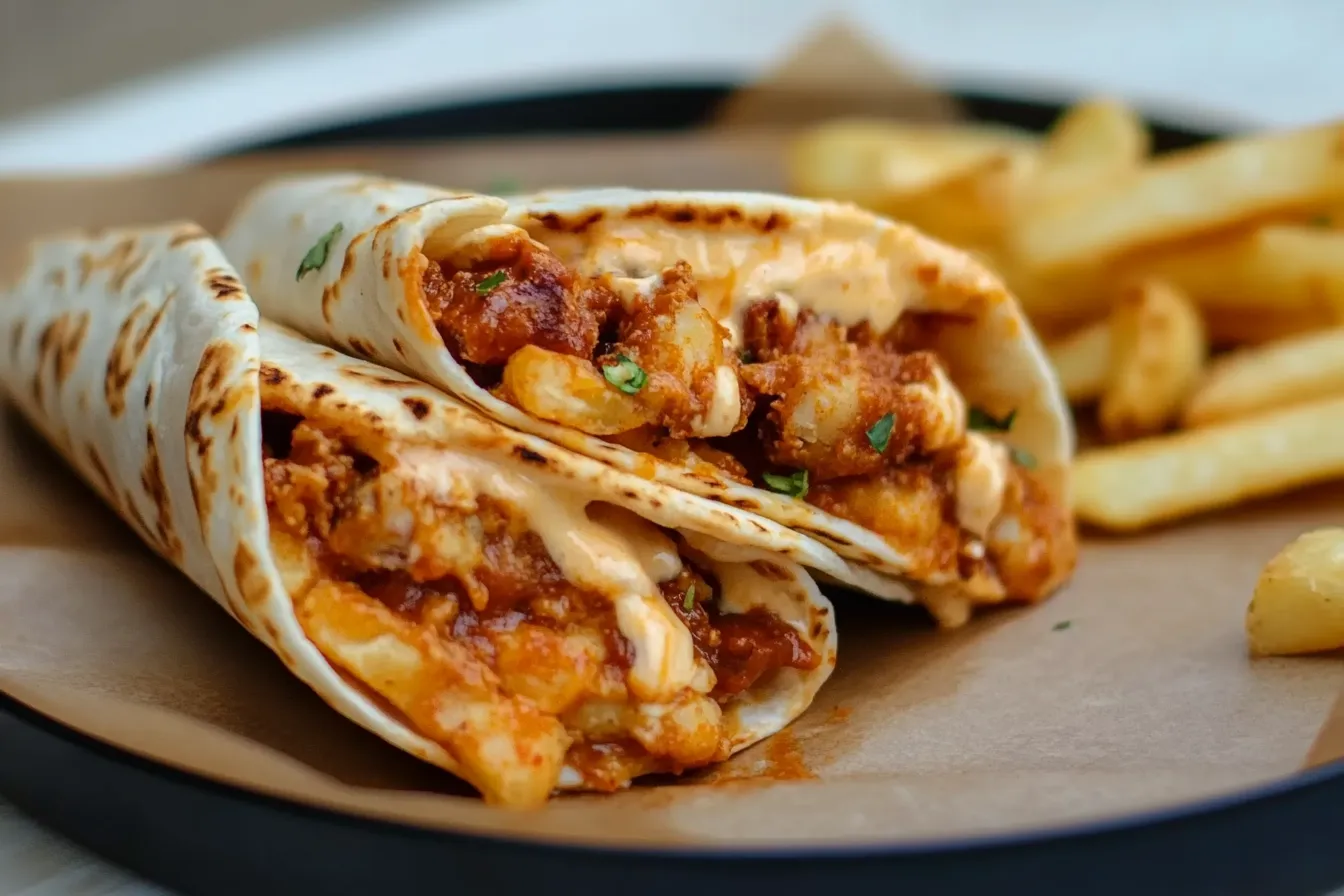Have you ever found yourself craving something bold, indulgent, and completely out of the ordinary? Maybe you’ve tried tacos, burritos, and wraps, but nothing quite hit the mark. Enter French tacos—a fast-food marvel that’s turning the world of handheld meals on its head. These aren’t your average tacos. They’re stuffed with fries, smothered in creamy cheese sauce, and grilled to crispy perfection. Sounds tempting, right?
What Are French Tacos?
French tacos, despite their name, are not directly linked to traditional Mexican tacos. They originated in France during the early 2000s, particularly in the Rhône-Alpes region, with cities like Lyon and Grenoble serving as the birthplace of this unique culinary creation. These fast-food favorites blend the simplicity of a tortilla wrap with a rich variety of ingredients, offering a new take on street food.
Unlike the small and open-faced Mexican taco, French tacos are fully enclosed, grilled wraps. They are packed with seasoned meats, crispy fries, creamy cheese sauce, and an array of customizable fillings. The dish appeals to those seeking a filling, portable, and affordable meal, making it a staple of urban fast food culture in France. Check out more recipes here.
How They Differ from Traditional Tacos

Although French tacos and traditional taco share some surface-level similarities, they are fundamentally different in preparation, ingredients, and presentation.
- Ingredients
Traditional tacos typically feature fresh and simple components like grilled meats, onions, cilantro, and salsa, all served in a small corn or flour tortilla. It is on the other hand, are loaded with fillings such as chicken, beef, or merguez sausage, along with fries, cheese sauce, and optional vegetables. - Preparation
Mexican tacos are often served unwrapped and focus on fresh, raw flavors. French tacos are tightly wrapped into a rectangular shape and grilled using a pressing technique, which gives them a crispy, golden exterior. - Portion Size and Style
French tacos are more substantial than their Mexican counterparts, designed as a meal in themselves rather than as part of a larger spread.
These distinctions highlight the unique culinary identity of French tacos, which deviate significantly from their Mexican inspiration. Check out more recipes here.
The Cultural Fusion Behind the delicacy
It represents a fascinating blend of French, North African, and Mexican culinary traditions, reflecting the multicultural dynamics of French society.
- French Influence
The inclusion of rich cheese sauces, fries, and a focus on indulgent textures highlights French culinary preferences. - North African Influence
The dish owes much of its flavor to North African culinary practices, as many early creators of French tacos came from North African immigrant communities. Halal meats, bold spices, and grilling techniques play a central role. - Mexican Inspiration
While the tortilla and the concept of wrapping food have Mexican origins, French tacos diverge from the traditional form to become a unique creation.
This fusion of influences mirrors the broader cultural exchanges in France, where diverse flavors come together to create innovative new dishes.
Popularity in France and Beyond
The delicacy quickly rose to prominence among younger audiences in France, particularly in urban areas. Their affordability and adaptability made them a popular choice for students, workers, and families. Over time, their appeal spread to other parts of Europe and the Middle East.
- Affordability
French tacos provide a complete, filling meal at a reasonable price, making them an attractive option for budget-conscious diners. - Convenience
Their compact, portable design fits seamlessly into the fast-paced lifestyles of modern consumers. - Social Media Influence
Viral videos showcasing the preparation of French tacos, with their pressed grilling and oozing cheese, helped propel their global popularity.
The dish’s ability to cater to halal dietary preferences further contributed to its widespread acceptance in diverse communities. Check out more recipes here.
The Evolution of Street Food in France
It is a shining example of how street food in France has transformed in recent years. Traditionally dominated by options like crepes and baguette sandwiches, the French street food scene now embraces a broader range of flavors and influences.
- Breaking Traditional Boundaries
French tacos challenge the perception of cuisine as refined and complex, offering a casual and approachable alternative. - Embracing Multiculturalism
Their popularity among France’s diverse population showcases how culinary innovation often emerges from cultural intersections.
It is now a defining feature of modern street food culture, bridging the gap between traditional flavors and global influences.
Signature Ingredients
The delicacy stands out due to their combination of rich, indulgent ingredients that make them more substantial than traditional tacos. The key components include:
- Meats
French tacos typically offer a variety of meats, including chicken, beef, merguez (spiced lamb sausage), or kebab-style shawarma. The meats are often marinated and seasoned with bold spices for added flavor. - Fries
One of the most distinctive features of French tacos is the inclusion of crispy fries inside the wrap. This unconventional addition enhances the texture and makes the dish heartier. - Cheese Sauce
Creamy cheese sauce, often made with a blend of cheeses and spices, is a signature ingredient. It adds a velvety richness that complements the other components. - Optional Fillings
Diners can customize their tacos with additional ingredients like vegetables (lettuce, tomatoes, or onions), sauces (garlic, barbecue, spicy harissa), or even unconventional options like bacon or mushrooms.
This diversity of ingredients allows it to cater to a wide range of tastes and preferences, making them a versatile street food favorite. Check out more recipes here.
The Use of Cheese Sauce
Cheese sauce is arguably the defining feature of French taco. Unlike traditional tacos, which rely on fresh toppings like salsa and guacamole, the dish prioritizes a creamy, indulgent filling. The cheese sauce:
- Enhances Flavor
It provides a rich and savory base that complements the seasoned meats and fries. - Improves Texture
Its creamy consistency balances the crunch of the fries and the grilled tortilla. - Adds Versatility
Different variations of cheese sauce can be used to create unique flavor profiles, from mild and buttery to sharp and spicy.
The focus on cheese sauce reflects a distinctly French appreciation for creamy, decadent foods, setting French taco apart from their Mexican counterparts.
Customization Options

One of the biggest reasons for the popularity of it is their ability to be customized. Diners have the freedom to build their perfect taco by choosing:
- Base Meat
Options typically include chicken, beef, merguez, or vegetarian alternatives like falafel. - Add-Ons
Additional fillings, such as fresh vegetables, extra cheese, or specialty sauces, let customers personalize their meal. - Sauces
From classic garlic sauce to fiery harissa or tangy barbecue, the choice of sauces allows for endless flavor combinations.
This level of customization ensures that French taco can cater to diverse palates and dietary preferences, making them a universal favorite.
The Tortilla and Its Role
The tortilla used in the dish plays a critical role in their distinctiveness. While traditional Mexican tortillas are small and often made from corn, French tacos use large flour tortillas for their wraps. These tortillas:
- Provide Structure
Their size and flexibility allow them to hold a large amount of filling without tearing. - Adapt to Pressing
Flour tortillas are ideal for the grilling and pressing process, which creates the iconic rectangular shape and a crispy, golden-brown exterior. - Enhance Versatility
Their neutral flavor complements the bold ingredients inside without overpowering them.
The use of flour tortillas and the pressing technique set French tacos apart from not only Mexican taco but also other types of wraps and burritos. Check out more recipes here.
The Pressing Technique
A hallmark of French tacos is their preparation process, particularly the grilling and pressing technique. After the tortilla is filled and wrapped, it is placed in a hot press, which:
- Seals the Wrap
The pressing ensures that the wrap stays closed, making it easier to handle and preventing ingredients from spilling out. - Creates a Crispy Exterior
The grilling process gives the tortilla a golden-brown crust, adding a satisfying crunch to each bite. - Enhances Flavor and Texture
The heat from the press melds the ingredients together, creating a harmonious blend of flavors while maintaining distinct textures.
This technique not only improves the practicality of it as a portable food but also adds to their visual and sensory appeal.
Why French Tacos Are So Unique
French taco stands at the intersection of tradition and innovation, drawing inspiration from multiple cuisines while establishing their own identity. Their signature ingredients, focus on indulgence, and unique preparation techniques make them a standout in the world of street food. The combination of bold flavors, rich textures, and endless customization options ensures their place as a beloved fast-food staple.
French Tacos vs. Mexican Tacos
French taco and Mexican taco may share a name and use of tortillas, but their differences go far beyond the surface.
- Ingredients
Mexican tacos feature simple, fresh ingredients like grilled meat, onions, cilantro, and salsa, often served on a soft corn tortilla. French tacos, on the other hand, are a fusion dish that combines seasoned meats, crispy fries, cheese sauce, and a variety of customizable fillings. - Presentation
While Mexican tacos are typically open-faced, French tacos are tightly wrapped and grilled into a rectangular shape, making them easier to eat on the go. - Portion Size
Mexican tacos are often small and served in multiples, while French tacos are designed as a single, hearty meal. - Flavor Profiles
Mexican tacos emphasize fresh and tangy flavors, often incorporating lime juice and spicy salsas. French tacos focus on rich and indulgent flavors, with creamy cheese sauce and savory meats taking center stage.
These distinctions underline how French tacos have evolved into a completely unique dish, inspired by Mexican taco but tailored to a different cultural context.
French Tacos vs. Burritos
The delicacy is often compared to burritos due to their similar appearance and structure, but key differences set them apart.
- Filling Composition
Burritos typically feature beans, rice, and proteins like chicken or beef, along with salsa, guacamole, and cheese. French tacos exclude beans and rice, instead including fries and cheese sauce as defining elements. - Preparation Technique
Burritos are wrapped and served as-is, while French tacos are grilled and pressed to achieve their distinct rectangular shape and crispy exterior. - Cultural Origins
Burritos are rooted in Mexican and Tex-Mex traditions, while French tacos emerged as a multicultural fusion in France, combining French, North African, and Mexican influences.
The pressing technique and the inclusion of fries make it a unique creation that is distinct from burritos despite their visual similarities.
Global Variations and Interpretations
As the french treat have gained international popularity, they have been adapted to suit local tastes and preferences.
- Middle East
In countries like Morocco and Algeria, French tacos are popular due to their compatibility with halal dietary practices. Regional spices and fillings, such as shawarma meat or harissa sauce, are often added. - United Kingdom
In the UK, it is increasingly popular among students and young professionals. British versions might include fillings like chicken tikka or peri-peri sauce for a local twist. - United States
While not as widespread in the US, French tacos have found a niche in urban areas. Some versions incorporate American-style ingredients, like pulled pork or cheddar cheese, to appeal to local palates.
These adaptations demonstrate the versatility of it and their ability to integrate into diverse culinary landscapes.
Health Implications of French Tacos

It is undeniably delicious, but their indulgent nature means they are not always the healthiest option.
- Caloric Content
The inclusion of fries, cheese sauce, and large portions of meat makes French tacos a calorie-dense meal. A single serving can contain upwards of 1,000 calories, depending on the size and fillings. - Nutritional Balance
While rich in protein from the meat, French tacos are often low in fiber and high in fat due to the cheese sauce and fries. Adding vegetables can improve their nutritional profile. - Dietary Flexibility
French tacos can be made vegetarian or even vegan by substituting meat and cheese with plant-based alternatives. Lighter options, such as grilled vegetables or lean proteins, are also becoming more common.
While they are a treat rather than an everyday meal for health-conscious individuals, French tacos can be modified to suit different dietary needs.
The Future of French Tacos
The rise of the delicacy reflects broader trends in global food culture, and their future appears bright with several exciting possibilities:
- Expansion into New Markets
As awareness of French tacos grows, more countries are likely to embrace this dish, with local adaptations to suit regional tastes. - Health-Conscious Versions
With the increasing demand for healthier fast-food options, we may see more balanced versions of French tacos featuring whole-grain tortillas, grilled proteins, and lighter sauces. - Innovative Flavors
Chefs and food entrepreneurs are likely to experiment with new fillings and sauces, creating gourmet and premium versions of French tacos. - Technology Integration
Ordering apps and delivery platforms are likely to play a significant role in the continued success of French tacos, making them even more accessible.
The adaptability and appeal of it suggest that they will remain a prominent feature in global fast-food culture for years to come.
FAQs
- What makes French tacos different from traditional taco?
French tacos are fully enclosed wraps filled with seasoned meats, fries, and cheese sauce, unlike traditional taco, which are open-faced with fresh ingredients. - Where did French tacos originate?
They originated in France, particularly in the Rhône-Alpes region, during the early 2000s. - Are French tacos healthy?
While delicious, they are calorie-dense due to ingredients like fries and cheese sauce. Healthier versions are possible with lighter fillings and more vegetables. - What is the signature ingredient in French tacos?
Cheese sauce is the standout component that sets it apart from other wraps. - How are French tacos prepared?
They are filled, wrapped in a large flour tortilla, and pressed on a grill to achieve their distinct shape and texture. - Are French tacos customizable?
Yes, diners can choose from a variety of meats, sauces, and add-ins to create their perfect taco. - Can French tacos be vegetarian or vegan?
Absolutely. Many places offer vegetarian or vegan options using plant-based proteins and dairy-free cheese. - Why are fries included in French tacos?
Fries add texture, flavor, and a sense of indulgence, making the dish more filling. - Are French tacos popular outside of France?
Yes, they have gained popularity in Europe, the Middle East, and beyond, with local adaptations in each region. - What does the future hold for French tacos?
With growing global interest, expect new markets, healthier options, and creative flavor innovations in the coming years.
